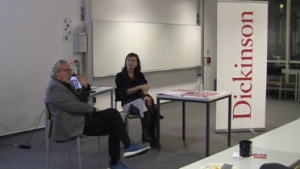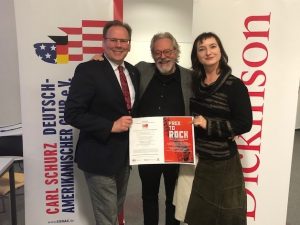by Molly Wells ’21
Like most other American university students studying abroad, I too was sent home early due to the cancellation of the Dickinson-in-Germany program. All I seemed to read and hear for a while is about the coronavirus and how “the world is ending.” I, for one, was slowly coming to terms with the fact that these next few months would not be the ones in which I live in Bremen. Because, however, I spent some of the best weeks of my life in Bremen, I have chosen to focus on the positive and fun aspects of my time there.
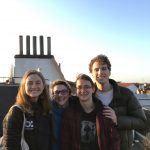 The best experiences in life revolve around the people that one meets. This was certainly true of my experience in Bremen. I could not have asked for a better group of people to study abroad with. Each one of us desired to fully immerse ourselves in Bremen culture as well as truly improve our German. The “springies” (students studying abroad in the spring) consisted of five language nerds ready for adventure. And what an (short) adventure we had.
The best experiences in life revolve around the people that one meets. This was certainly true of my experience in Bremen. I could not have asked for a better group of people to study abroad with. Each one of us desired to fully immerse ourselves in Bremen culture as well as truly improve our German. The “springies” (students studying abroad in the spring) consisted of five language nerds ready for adventure. And what an (short) adventure we had.
My second evening in Bremen (and other students’ first) was spent in an Irish pub in the Viertel of Bremen watching a Werder Bremen soccer game. While I 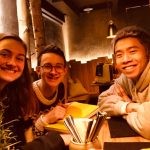 cannot say I watched a lot of the game, I was thoroughly entertained by the reactions and faces of the German soccer fans. Werder Bremen was (and still is) doing quite poorly in the league as I understand it, but that game was quite an exception. They ended up defeating one of the best teams in Germany. I took this as a sign that my time in Bremen was going to be just like that: a great victory in the face of adversary. In some ways, it was.
cannot say I watched a lot of the game, I was thoroughly entertained by the reactions and faces of the German soccer fans. Werder Bremen was (and still is) doing quite poorly in the league as I understand it, but that game was quite an exception. They ended up defeating one of the best teams in Germany. I took this as a sign that my time in Bremen was going to be just like that: a great victory in the face of adversary. In some ways, it was.
One of the more “German” experiences I had revolved around what is known as a “Kohl-Tour.” When I first heard of this mysterious activity, I thought people were saying “Kultur” which means “culture.” I thought this sounded like the perfect way to immerse myself in Bremen culture, since the activity itself was named “culture!” While “Kohl-Tour” in fact means “kale (or cabbage) tour,” it did show me a glimpse of Bremen culture. We gathered on a Saturday mid-morning with shopping carts full of alcohol and loudspeakers. We then proceeded to walk in a huge loop which was probably around six miles long. Every so often, the leaders of the group would announce “Kreuzung!” and we would stop and play various games or crack open a new beer. I was mostly fascinated by how accommodating everyone was. Something like this would be seen as extremely disruptive in the US, but we didn’t travel through any neighborhoods, and everyone who passed us met us with a smile and a wave. Every time a bike was seen headed our way, we would shout “Fahrrad!” until everyone had moved to the sides of the path. At the end of our long journey, we gathered to eat the famous “Grünkohl” (kale cooked with sausages or veggie sausages) that had been cooked earlier that morning. It was a great way to meet other Uni Bremen students as well as get a taste of part of Bremen culture. I thought I had walked a great distance during this experience, but little did I know, it would not be my farthest walking adventure I had in Bremen, Germany.
Another of the “springies” and I were supposed to go to Poland on an excursion in early March, but this was the first trip to be cancelled due to the outbreak of COVID-19. We decided we wanted to travel somewhere ourselves during this time instead. I love hiking and have only been “real” backpacking once, but I knew I wanted to try my hand at the activity again in Germany. The other “springie” loves walking and can walk for miles upon miles without getting tired. Therefore, we decided we should go on a backpacking trip. We did not have camping gear, and my walking partner was not entirely attracted to the idea of sleeping on the ground for four nights, so we decided we would stay in hostels instead. I’ll just say I don’t think my body would have survived if it hadn’t had a bed to sleep in each night, given the amount of walking we did.
We decided we wanted to walk along the Rhine river; I had found a bike path we could follow that was supposed to take us through a nice scenic route hitting three major cities. We took a bus down to Bonn and then walked to Cologne and then Düsseldorf in four days. Turns out that the route I had found was under water in early March, but we persevered nonetheless. Our total distance walked ended up being around seventy miles, and the sites were beautiful. My feet were not quite as beautiful; I still had two blood blisters over a month after we got back…


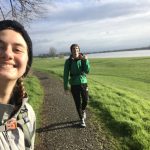
Despite the bodily pain of the trip, I had such a great time. Seeing a different part of Germany was wonderful and walking through it was even better. Walking forces one to take in all the details of a place. The places and the river we took in were simple yet magnificent. I returned to Bremen, however, with the conclusion that none of the cities we had traveled through were as beautiful as Bremen.
There were so many other experiences I had during my time in Bremen, but I have ramble d about my emotional attachment to the place long enough. Each experience I had was only incredible because of the people I shared them with. While I wished I could have spent more time in the beautiful city of Bremen, I know I will return soon. I will forever be grateful for the six weeks I was able to spend there. Thank you, Bremen.
d about my emotional attachment to the place long enough. Each experience I had was only incredible because of the people I shared them with. While I wished I could have spent more time in the beautiful city of Bremen, I know I will return soon. I will forever be grateful for the six weeks I was able to spend there. Thank you, Bremen.
















